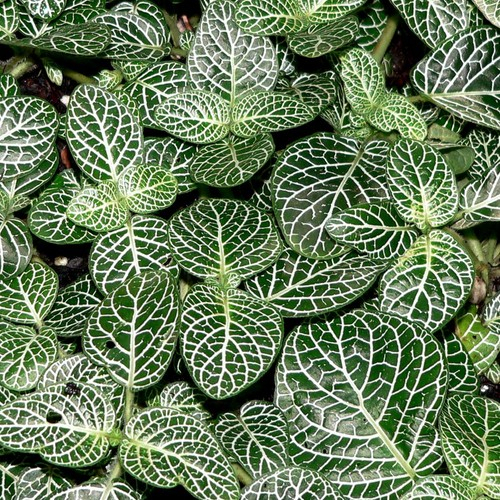Indoor plants Fittonia

Description
Special Features of Fittonia
Fittonia is a magnificent plant very popular among indoor plant enthusiasts. It is easily recognizable with its dark green leaves completely covered with characteristic delicate veins. The most popular species have a silver white pattern but plants with white, pink, green, and other colourings are also commonly available. Commercial growers are constantly working on breeding new varieties with new characteristics, featuring more vivid and striking contrasts.
This perennial herb native to Peru was named after Elizabeth and Sarah Mary Fitton, the authors of a classic English botany textbook. The genus Fittonia belongs to the acanthus family and contains about ten species. The most popular of them is Verschaffeltii with dark green leaves and pink veins and Argyroneura with light green leaves and white veins.
Fittonia is successfully grown in greenhouses. For indoor cultivations, dwarf varieties are more suitable. Unfortunately, broad-leaves Fittonias are fastidious enough and beginners must be very careful when starting this plant. Carefully reading care requirements and following them strictly is essential to ensure healthy growth and development.
The Secrets to Successfully Growing Fittonia
Fittonia will thrive close to the window in a slightly shaded place with filtered sunlight. Be careful! Direct sunlight can cause significant damage to the plant resulting in sunburn.
Fittonia prefers warm and moist soil with good drainage. Do not let the soil dry out between waterings. To avoid waterlogging that can cause root rot, use special pots with drainage holes and trays for the drainage of excess water. Repot the plants every year in spring. The soil composition should be the following: 1 part peat moss, 2 parts humus, and 1 part coarse sand.
Right temperatures and humidity is the key to successfully growing Fittonia. The minimum temperature allowed for this plant is 18-20 C; the maximum temperature is 27 C. The best temperatures are 24-25 C.
Fittonia can be propagated easily in the late spring or early summer. Take tip cuttings from adult plants and insert in wet soil or water. If in water, the cuttings will root soon enough and you can pot the young plants in the peat-based soil. During propagation, make sure to maintain the temperature favourable for this plant.
Potential Problems
In indoor cultivation, Fittonia rarely gets pests. Nevertheless, the waterlogged soil may result in the appearance and development of insect larvae. To get rid of them, replant Fittonis in fresh soil.
Thrips, mealy bugs, and spider mites are most common plant pests that affect Fittonia. Thrips are small agile insects that suck cell sap from the plant tissues. Pests may weaken Fittonia and cause various diseases, including those transmitted by thrips. To reduce the probability of occurrence of thrips, it is necessary to maintain high humidity. Regularly inspect the plants and remove pests. Use tape insect traps. Apply insecticides two or three times every ten days.
Mealybugs usually occur in the leaf joints. In severe cases, typical secretions reminiscent of small cotton wool lumps can be detected on the surface of the leaves. To get rid of the pest, wipe the leaves with a damp cloth soaked in soapy water, alcohol, or an alcohol solution.
Spider mites affect healthy plants and can cause some types of leaf spot and decrease vital functions of Fittonia. Spider mites are encouraged by the air that is too dry. To cope with the pests, maintain high humidity levels, which will create an unfavorable environment for them.
If the plant leaves turn yellow and wither, the reason can be overwatering. Reduce watering and its leaves will go back to normal colour and condition over time. On the contrary, with underwatering the leaves begin to shrivel and curl. The plant can recover if you act promptly. Allow no more overwatering as after your Fittonia may not survive next time.
Leaves can shrivel with underwatering and too much light. Spray the plant with warm water and make sure it is protected from direct sunlight. This should help to resolve the issue.
Fittonia's browning leaf tips indicate a lack of or, alternatively, an excess of soil minerals.
Try to determine the cause and resolve the issue.
Be careful and attentive and your plant will be grateful for your efforts.







 5 351
5 351







